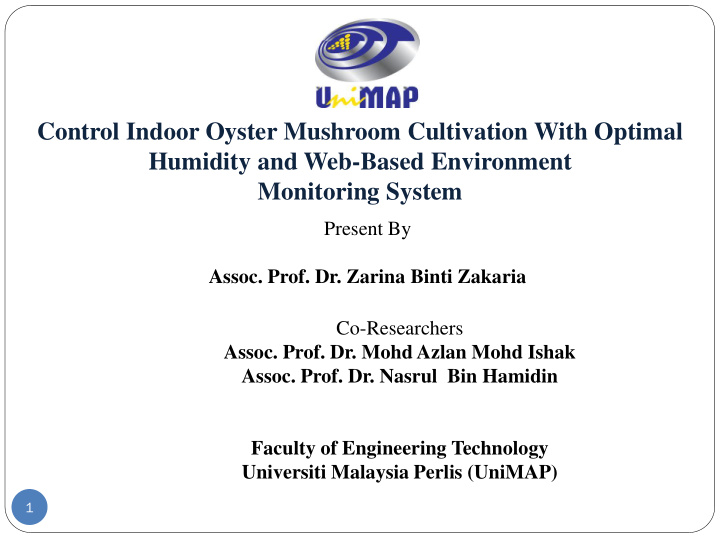



Control Indoor Oyster Mushroom Cultivation With Optimal Humidity and Web-Based Environment Monitoring System Present By Assoc. Prof. Dr. Zarina Binti Zakaria Co-Researchers Assoc. Prof. Dr. Mohd Azlan Mohd Ishak Assoc. Prof. Dr. Nasrul Bin Hamidin Faculty of Engineering Technology Universiti Malaysia Perlis (UniMAP) 1
OBJECTIVES To use and monitor the indoor cultivation system with web-based monitoring system for various capacity of substrate bags loading of 3000, 5000 and 7000 for mushroom production. To monitor parameters capacity such as humidity, temperature and ventilation at various substrate bags loading on optimized condition sustainability. To empower human capital such as undergraduates, postgraduates, graduate intern and industrial attachment of staff in production, commercialization and entrepreneurship management. 2
PRODUCT OPTIMAL HUMIDITY AND WEB-BASED ENVIRONMENT MONITORING SYSTEM FOR INDOOR OYSTER MUSHROOM CULTIVATION 3
Description of Prototype Including its Originality Room Size : 5.8 × 4.6 × 2.7 m 3 Wall : one side made by bricks rest sides made by gypsum Roof : made by gypsum board under main concrete roof Ventilation : Roof ventilation 4 Side ventilation 3 Light: 1 LED tube rod light Rack : 4 racks ( 55cm distance) 4 bar in each rack ( 15 cm ) Rope : hanged to arrange the bags. 76 cm distance from roof , 30 cm distance from floor . Sensor: Humidity and Temperature connecting by WiFi This cultivation prototype will be equipped with several humidifiers that will be operated according to characterization and optimization outcomes from previous studies. 4
PILOT PROTOTYPE CONCEPTUAL Important Factors for Common Indoor Cultivation Reference Mushroom Cultivation Problems from System Advantages Conventional Cultivation Crucial Environmental High Able to monitor and Upadhyay et al., 2011 Factors temperature control the humidity and Low humidity in the eventually temperature Contamination High Reduce Jang et al., 2003 contamination contamination risk Upadhyay et al., 2011 rate since expose to open environment Pleurotus spp. Cap size, yield Highest in 0.03% Jang et al., 2003 Oyster mushrooms Cap size, stalk cap size stalk in Cha et al., 2004 CO 2 Oyster mushrooms Cap size, stalk from 0.05% or more 5 Cha et al., 2004
PILOT PROTOTYPE CONCEPTUAL Able to reduce contamination risks Able to monitor and control crucial environment factors such as humidity, air flow (CO2), temperature and light. 6
POTENTIAL FOR COMMERCIALIZATION Increased Mushroom Yield (Data for 200 bags) Indoor Cultivation System Conventional Cultivation Difference 70 70 261.8 kg (3 month) 140.3 kg 121.5 kg (4 months) 59.2 60 60 23.9 48.1 50 50 Kilogram (kg) 42.3 17.6 37.6 40 40 18.5 31.6 20.1 35.3 30 30 25.7 21.3 30.5 21.6 17.3 20 20 23.8 17.5 17.3 10 10 10.3 0 0 4.1 1 2 3 4 5 6 7 1 2 3 4 5 6 7 Number of Cycle Number of Cycle 7
POTENTIAL FOR COMMERCIALIZATION (Cont..) Data for 1500 bags 50 Yield (Kg) 45 40 35 30 Mushrooms 25 20 15 10 5 0 1 2 3 4 5 6 7 Number of Cycle 8
POTENTIAL FOR COMMERCIALIZATIOM (Cont..) Moisture Containing fruitbodies indoor and conventional cultivation Conventional Cultivation Indoor Cultivation System 9
DISADVANTAGES OF OTHER SYSTEMS - Conventional - Cannot mushroom control the house. humidity - Roof with - - Just apply surrounding water to netting reduce temperature - Mostly used by cultivators - Fully covered - Humidity is not block bulding monitored and - Just apply water control on the floor - Waste water just - No humidity and to endure the temperature floor is monitoring and continuously controlling wet 10
Description of Similar Product Available in the Market and Existing Market Size In Malaysia:- number of mushroom cultivators increased from 339 in 2007 to 428 in 2014 (Rosmiza et. al, 2016). about 80% of them are small cultivators (below 50 kg /day). about 17% are medium scale ( 50-500 kg per day), about 3% are big scale industries (> 500 kg/day) (Haimid et al., 2013). The number of cultivators are fluctuating due to unstable production and market changes improper documentation from the authority unable to produce as demand or desired scale. Whereas, the daily demand for fresh mushrooms was 47% higher than the supply in 2007 (Ismail 2007) 108% higher than the supply in 2010 (MOA 2010) 11
METHODOLOGY OF PTOTOTYPE Phase 1 • Construction of Building Phase 2 • Indoor Mushroom Cultivation System Set up • Mushroom Production Monitoring and Controlling Phase 3 • Products Harvesting, Evaluation and • Commercialization Phase 4 12
Q/A TERIMA KASIH 13
Recommend
More recommend